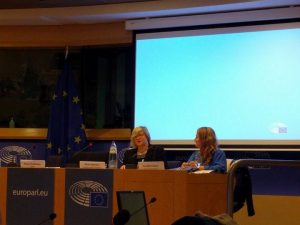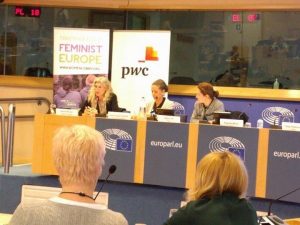28/02, Brussels In honour of the Herstory theme behind this year’s Ad Venture Student Competition, which is organised in partnership with the European Women’s Lobby (EWL), the edcom team has been getting to grips with topics of gender equality and women’s rights. With two weeks left for our Ad Venture students to work on their campaigns, edcom decided to head out to find some more inspiration for its students. Our search brought us to a panel discussion at the European Parliament on the topic of the under-representation of women in executive positions, organised by our client EWL.
 We enter the room and the title of the event – “Where are the executive women?” – is projected onto the wall behind us. There, a fantastic line-up awaited us: 7 highly successful women from across the private and public spheres. These included two MEPs from the European People’s Party (Angelika Miller and Sirpa Pietikainen), Gilly Lord: Account Manager at PwC, Grace Stevens: Chief Tax Officer at Legal & General Group, Karine Becker: Managing Partner at Higher and Hire, and Jason-Louise Graham from EU Panel Watch and ACP Young Professionals.
We enter the room and the title of the event – “Where are the executive women?” – is projected onto the wall behind us. There, a fantastic line-up awaited us: 7 highly successful women from across the private and public spheres. These included two MEPs from the European People’s Party (Angelika Miller and Sirpa Pietikainen), Gilly Lord: Account Manager at PwC, Grace Stevens: Chief Tax Officer at Legal & General Group, Karine Becker: Managing Partner at Higher and Hire, and Jason-Louise Graham from EU Panel Watch and ACP Young Professionals.
After a bit of mingling over a sandwich buffet, we take our seats and Gilly Lord opens the conference by explaining the particular way her daughter, aged nine, had interpreted the title of the day’s event, having that morning asked her: “Mummy, are you going on a treasure hunt to find all the women?” As the panel soon confirmed, there are indeed many “lost” executive women hiding in the rainy alleys of Brussels.
On average in Western Europe, only 25% of executive positions are held by women. In Eastern Europe, this proportion is slightly higher (at 34%) – a legacy of the more egalitarian communist era.
Yet, unfortunately for Gilly Lord’s daughter, as well as the rest of society, the problem is more complicated than simply locating these lost executive women. During the course of the panel discussion, three main problems were highlighted and discussed.
Unconscious bias and the fixed image of a male leader
All panel members agreed upon the important role that unconscious bias has in determining the face of the workplace. And as the name itself suggests, these kinds of decisions are made without even being recognised as prejudicial. Examples of unconscious bias can range from managers overlooking female employees for promotions because of an assumption that they will invest more time and energy into their family life, to the interpretation of a woman’s biologically softer voice as symptomatic of an “un-managerial” character style.
As Karine Becker highlighted, whilst women do tend to be less assertive than men, this is often translated to employers as evidence of “a lack of leadership” skills. However, as MEP Sirpa Pietikainen most clearly remarked, these assumptions are linked to a rather outdated attitude towards leadership:
“It is time we recognised a true diversity of leadership styles and recognise that one can gain leadership skills from all walks of life. First and foremost – being a mother, one of the most difficult jobs of all.”
Structure and culture of workplaces

On top of this, the panel also highlighted far more subtle aspects which can have a negative impact on a woman’s career. Most notably, the panellists from the private sector stressed the continued existence of typically “male” office cultures. As Grace Stevens put it: “In my profession, there is unfortunately still a lot of strategizing which women are left out of simply because they take place during “guy-to-guy” chats in the corridors or down the pub after work…”
… So, how do we make a change?
Create determined and confident women through mentoring

Many of the panellists shared the opinion that the best practical way of boosting the confidence of women is by providing them, from the very beginning of their career, with guidance and support from more senior professionals in the industry. Such mentoring schemes can consist in periods of “shadowing” a senior executive or even participating in a “job swap”. Grace Stevens highlighted the importance of a simple dialogue between fellow professional women, who are often best placed to reinforce the confidence of each other: “Often it is as simple as two women sitting over coffee and encouraging each other to push themselves further.”
A change of approach at the recruitment stage: transparency, diversity and tackling bias


Students & HerStory
Listening to the thought-provoking analyses and ideas which emerged from the discussion left the edcom team thoroughly re-energised for its Ad Venture competition. edcom and EWL strive to contribute to the important debate by challenging students to create a campaign to raise awareness about gender inequality. With the deadline for students to submit their work on 15th March, we can’t wait to see what innovative and creative Herstory campaigns they have come up with!


